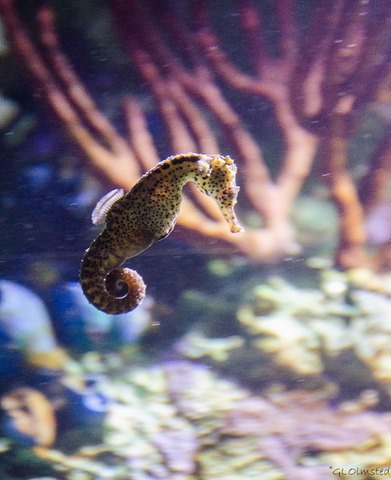 At first I was hesitant because I don’t like to see animals caged, in this case by glass. However the exhibits at Oregon Coast Aquarium are mesmerizing. They held no large animals, even though no enclosure can be big enough or as expansive as the sea. This educational facility promotes environmental awareness, conservation and good stewardship through enjoyment, education and research.
At first I was hesitant because I don’t like to see animals caged, in this case by glass. However the exhibits at Oregon Coast Aquarium are mesmerizing. They held no large animals, even though no enclosure can be big enough or as expansive as the sea. This educational facility promotes environmental awareness, conservation and good stewardship through enjoyment, education and research.
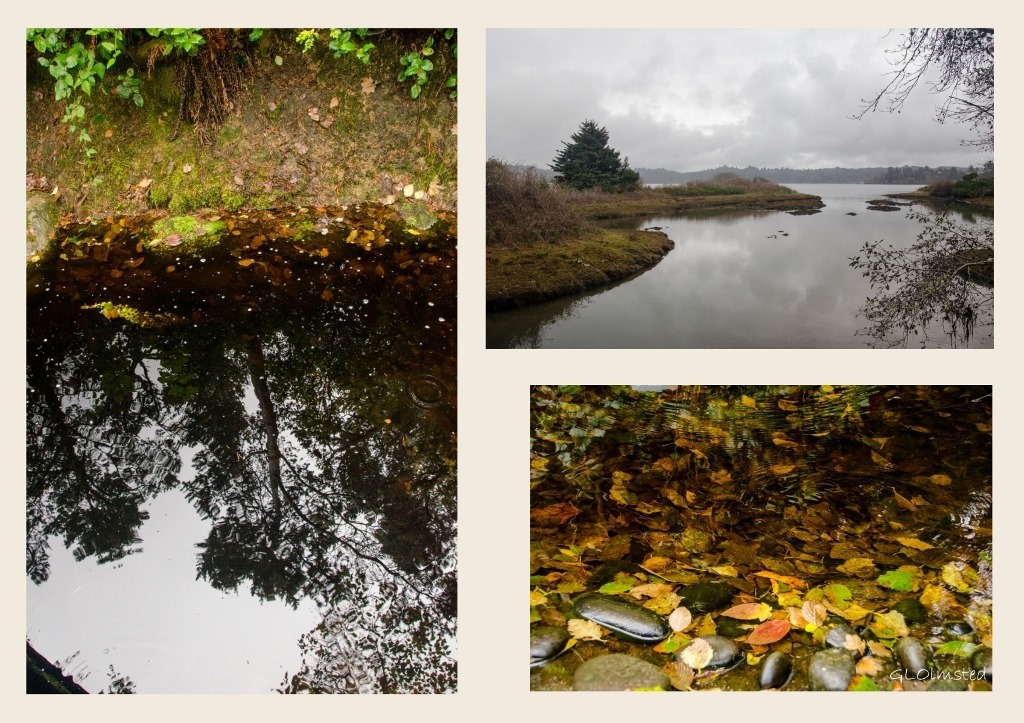 Upon entering the aquarium grounds the environment changed from a bustling Newport to a natural forest. No wonder, as the aquarium gardens feature over one hundred plant species, creating a lush and ever-changing natural environment. Red Alder, Creek Dogwood and towering Big Leaf maple trees cast long reflections in the trickling stream full of fall leaf colors. A small beaver dam with a tranquil saltwater marsh could be seen beyond the trees. The process used to reclaim the land on which the aquarium sits is called “naturescaping,” or landscaping with native plant life. Before the 1990s construction the southern end of the Yaquina Bay had been turned into a dumping ground by local industry.
Upon entering the aquarium grounds the environment changed from a bustling Newport to a natural forest. No wonder, as the aquarium gardens feature over one hundred plant species, creating a lush and ever-changing natural environment. Red Alder, Creek Dogwood and towering Big Leaf maple trees cast long reflections in the trickling stream full of fall leaf colors. A small beaver dam with a tranquil saltwater marsh could be seen beyond the trees. The process used to reclaim the land on which the aquarium sits is called “naturescaping,” or landscaping with native plant life. Before the 1990s construction the southern end of the Yaquina Bay had been turned into a dumping ground by local industry.
Welcome to Oregon Coast Aquarium
 We entered through the main lobby and after buying tickets our photo was taken. Various options for copies of the photos could be purchased on the way out but we opted not to. There is a café and espresso stand attached to the lobby. Just outside the door and near one of the gift shops were two “Foto Fun” photo booths that we should have taken advantage of. Anyone remember strip photos for $1? I think the price has gone up a bit since I was a kid. Berta bought some gifts for her great grandsons including interactive and coloring books that look like fun. Large sculptures of sea life carved from wood or cast bronze decorated the walkways. Even the door handles were artistic like the one that looks like octopus tentacles that I shared on the Geogypsy Facebook page.
We entered through the main lobby and after buying tickets our photo was taken. Various options for copies of the photos could be purchased on the way out but we opted not to. There is a café and espresso stand attached to the lobby. Just outside the door and near one of the gift shops were two “Foto Fun” photo booths that we should have taken advantage of. Anyone remember strip photos for $1? I think the price has gone up a bit since I was a kid. Berta bought some gifts for her great grandsons including interactive and coloring books that look like fun. Large sculptures of sea life carved from wood or cast bronze decorated the walkways. Even the door handles were artistic like the one that looks like octopus tentacles that I shared on the Geogypsy Facebook page.
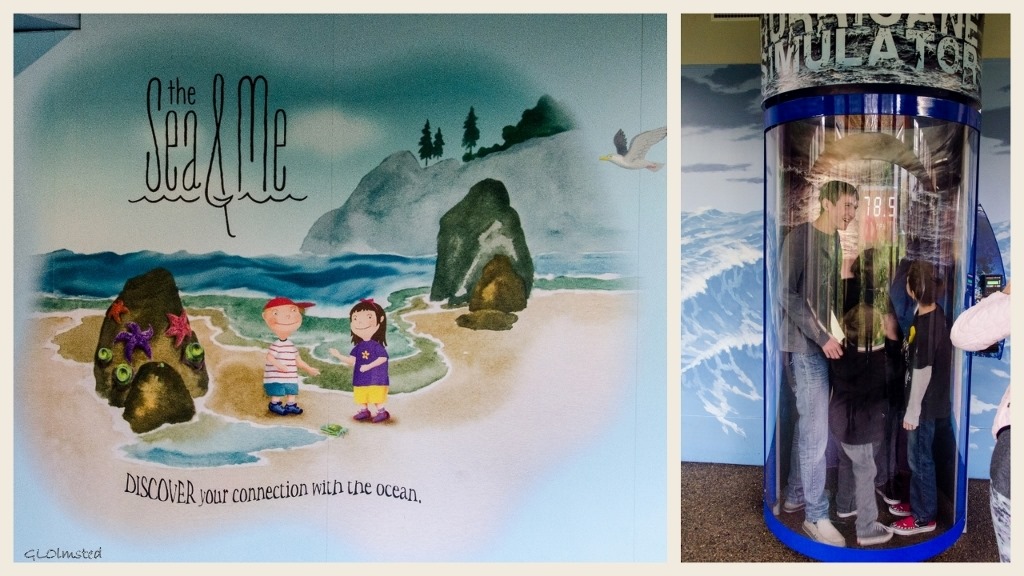 The Sea & Me provides interactive exhibits for children young and old like a submarine sea lab, kid-sized fishing boat complete with rubber bibs, a theater with activities, books and costumes, digging in the sand for agates and shells which I’d already done at the beach so left these behind, plus large tanks full of exotic colored fish. Berta donated $1 to the $2 hurricane force wind experience for these four boys and we watched their smiles increase along with the power of the wind. Note the 78.5mpr.
The Sea & Me provides interactive exhibits for children young and old like a submarine sea lab, kid-sized fishing boat complete with rubber bibs, a theater with activities, books and costumes, digging in the sand for agates and shells which I’d already done at the beach so left these behind, plus large tanks full of exotic colored fish. Berta donated $1 to the $2 hurricane force wind experience for these four boys and we watched their smiles increase along with the power of the wind. Note the 78.5mpr.
At the shore
We wandered from building to building working our way from the shore to the sea. I saw Tsunami warning signs all along the Oregon coast recommending to drop, cover and hold during an earthquake followed by walking briskly to high ground after the shaking stops. Undersea earthquakes occur along the Cascadia Subduction Zone running from northern California to British Columbia. A tsunami can deposit a layer of sea sand in its path creating sandy shores where sea life lives with human constructs like pier pilings and tidal pools in the surf zone.
 Rocky shores are frequent along the Oregon coast and animals have adapted to water at high tide and sun at low.
Rocky shores are frequent along the Oregon coast and animals have adapted to water at high tide and sun at low.
The Coastal Waters “At the Jetty” exhibit was my favorite with Moon jellies and Pacific Sea Nettles providing quite a show. However despite the common name of jellyfish, jellies aren’t fish. They float through life with no brain, no spine, no bones and no heart and are more than 95% water and salts. They swim by contracting the band of muscle fibers encircling the bell and because this gentle pulsing isn’t very strong they are considered plankton drifting with the currents. Some jellies sting with their tentacles to stun plankton and small fishes before eating them but we can also be stung both in the water and on the sand.
Hiding in the rocks
 The Giant Pacific Octopus was not to be seen. And although it may look fearsome is quite shy, sleeping by day in a rocky den or crevice to hide from predators. By night, it combs the seafloor seeking crabs, shrimp and other shellfish which it takes back to its den to eat then piles the empty shells outside in what’s called an octopus’s garden. So that’s where that Beetles line comes from.
The Giant Pacific Octopus was not to be seen. And although it may look fearsome is quite shy, sleeping by day in a rocky den or crevice to hide from predators. By night, it combs the seafloor seeking crabs, shrimp and other shellfish which it takes back to its den to eat then piles the empty shells outside in what’s called an octopus’s garden. So that’s where that Beetles line comes from.
Seabird Aviary
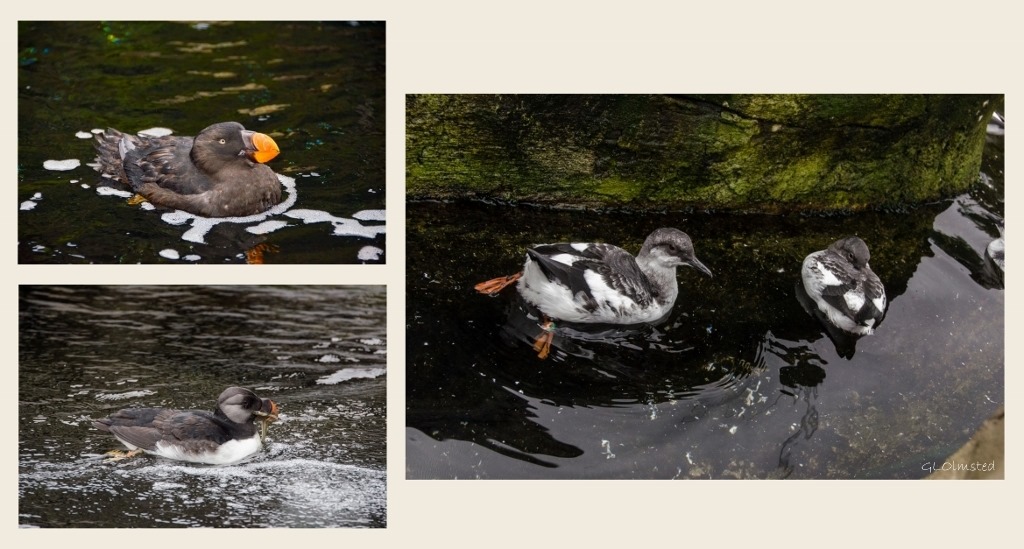 Horned Puffin, Pigeon Guillemots & Rhinocerous Auklet
Horned Puffin, Pigeon Guillemots & Rhinocerous Auklet
Next we wandered twisting trails between the rocks into the aviary where the species exhibited are members of the Alcid family commonly found off the Oregon Coast. They spend most of their lives at sea, returning to rookeries along the rocky coast once a year to breed. Veteran divers, Alcids gracefully “fly” underwater and frequently dive to depths of 30-40 feet (9-12 meters). Their diet consists primarily of small fish like herring or smelt. Except for the Black Oystercatchers that do not dive for fish, but chisel limpets, crabs and mussels from tide pool rocks and break them open with their beaks. I was very excited to see Tufted Puffins yet their fall plumage is not so dramatic as during mating season.
A separate exhibit houses a sibling pair of vultures, named Ichabod and Olive who were taken from their nest as hatchlings into a human home. Shortly thereafter, they were turned over to wildlife rehabilitation specialists who were able to provide the care they needed. But, as a result, they imprinted on human beings early and were unable to be released back into the wild.
Mammals of the sea
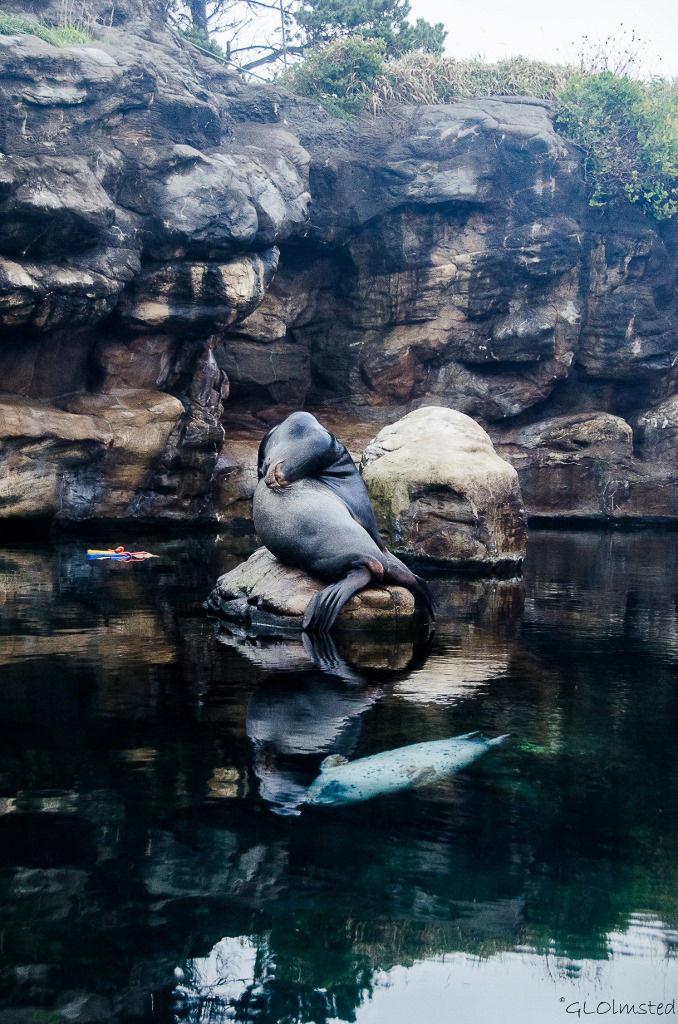 Harbor Seals and Sea Lions, known collectively as pinnipeds meaning feather- or fin-footed, share the same newly enlarged tank exhibit. Sea Lions are long, sleeker-looking and have large front flippers and a hinged pelvis which helps them to effectively navigate on land. Males have a large round forehead and are much bigger than females at 8 feet (2.4 meters) in length weighing 850 pounds (385 kilograms) while females are 6 feet (1.8 meters) in length and weigh 220 pounds (99.7 kilograms), both live 25-30 years.
Harbor Seals and Sea Lions, known collectively as pinnipeds meaning feather- or fin-footed, share the same newly enlarged tank exhibit. Sea Lions are long, sleeker-looking and have large front flippers and a hinged pelvis which helps them to effectively navigate on land. Males have a large round forehead and are much bigger than females at 8 feet (2.4 meters) in length weighing 850 pounds (385 kilograms) while females are 6 feet (1.8 meters) in length and weigh 220 pounds (99.7 kilograms), both live 25-30 years.
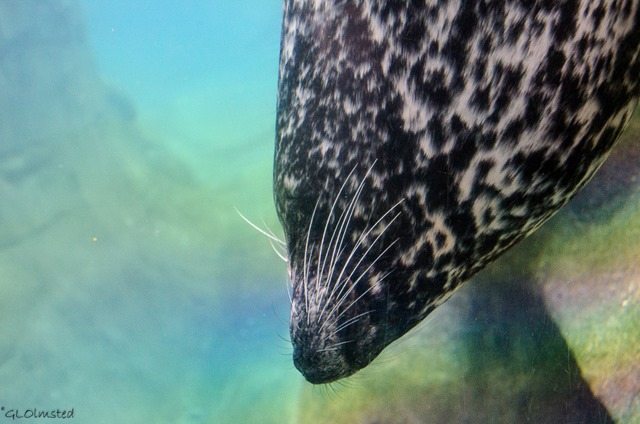 Harbor Seals are smaller and more “sausage shaped.” They have comparatively small fins and are not as vocal as the barking Sea Lions. About 6 feet (1.8 meters) in length, weighing 300 pounds (136 kilograms), and live 25-30 years, males and females look very similar. They often swim right up to the barrier for a closer look like this female who hung upside down and just seemed to stare at us. The surrounding rainbow colors must be from the glass/acrylic.
Harbor Seals are smaller and more “sausage shaped.” They have comparatively small fins and are not as vocal as the barking Sea Lions. About 6 feet (1.8 meters) in length, weighing 300 pounds (136 kilograms), and live 25-30 years, males and females look very similar. They often swim right up to the barrier for a closer look like this female who hung upside down and just seemed to stare at us. The surrounding rainbow colors must be from the glass/acrylic.
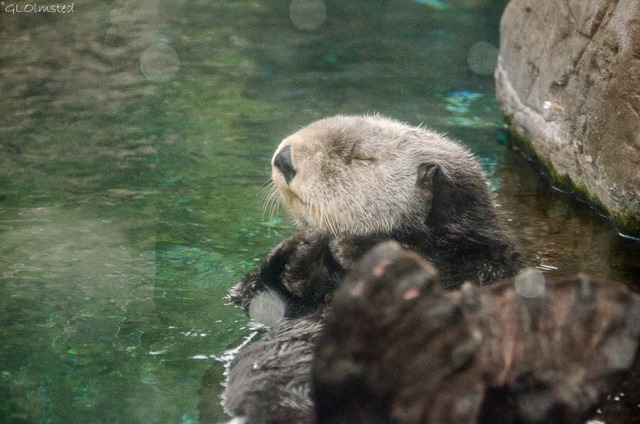 The all-male raft of Sea Otters is the largest population in the state of Oregon as they were hunted to extinction for their unique pelts with the last one being killed just off the Newport Beach in 1907. Protected since 1911, they are making a recovery in California, Alaska and Washington and are listed as Threatened under the Endangered Species Act. They control the population of sea urchins which in turn feed on the giant kelp forests offshore so their extirpation disrupted the ecological balance which allowed the destruction of many of the underwater forests and the habitat they provided for innumerable species. I am saddened by my fellow humankind’s treatment of life on our fragile planet. Seeing these adorable faces makes me question my own species’ right to live here. Although typically very playful they were all asleep after a recent feeding.
The all-male raft of Sea Otters is the largest population in the state of Oregon as they were hunted to extinction for their unique pelts with the last one being killed just off the Newport Beach in 1907. Protected since 1911, they are making a recovery in California, Alaska and Washington and are listed as Threatened under the Endangered Species Act. They control the population of sea urchins which in turn feed on the giant kelp forests offshore so their extirpation disrupted the ecological balance which allowed the destruction of many of the underwater forests and the habitat they provided for innumerable species. I am saddened by my fellow humankind’s treatment of life on our fragile planet. Seeing these adorable faces makes me question my own species’ right to live here. Although typically very playful they were all asleep after a recent feeding.
Passages of the Deep
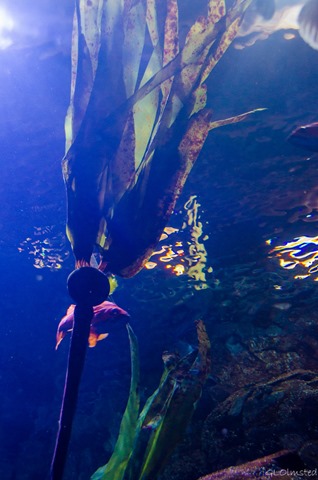 We almost missed this exhibit which moves through the depths of the sea. Didn’t see the sign and had to back track after directions from staff in the main lobby. Beginning with the Orford Reef which includes a cluster of submerged haystack rock formations with only the tops visible above water. Beneath the waves, the areas between these rocks form a deep reef of narrow crevasses and swaying forests of bull kelp. This gas-filled bulb is attached to the seafloor by a stipe that may be 100 feet (30 meters) long. The float buoys up the plant, keeping the blades near the surface where there’s plenty of sunlight. During the peak growing season, it can grow at a rate of 14 inches per day and provides food and shelter for a diversity of marine life including fish, invertebrates, and marine mammals.
We almost missed this exhibit which moves through the depths of the sea. Didn’t see the sign and had to back track after directions from staff in the main lobby. Beginning with the Orford Reef which includes a cluster of submerged haystack rock formations with only the tops visible above water. Beneath the waves, the areas between these rocks form a deep reef of narrow crevasses and swaying forests of bull kelp. This gas-filled bulb is attached to the seafloor by a stipe that may be 100 feet (30 meters) long. The float buoys up the plant, keeping the blades near the surface where there’s plenty of sunlight. During the peak growing season, it can grow at a rate of 14 inches per day and provides food and shelter for a diversity of marine life including fish, invertebrates, and marine mammals.
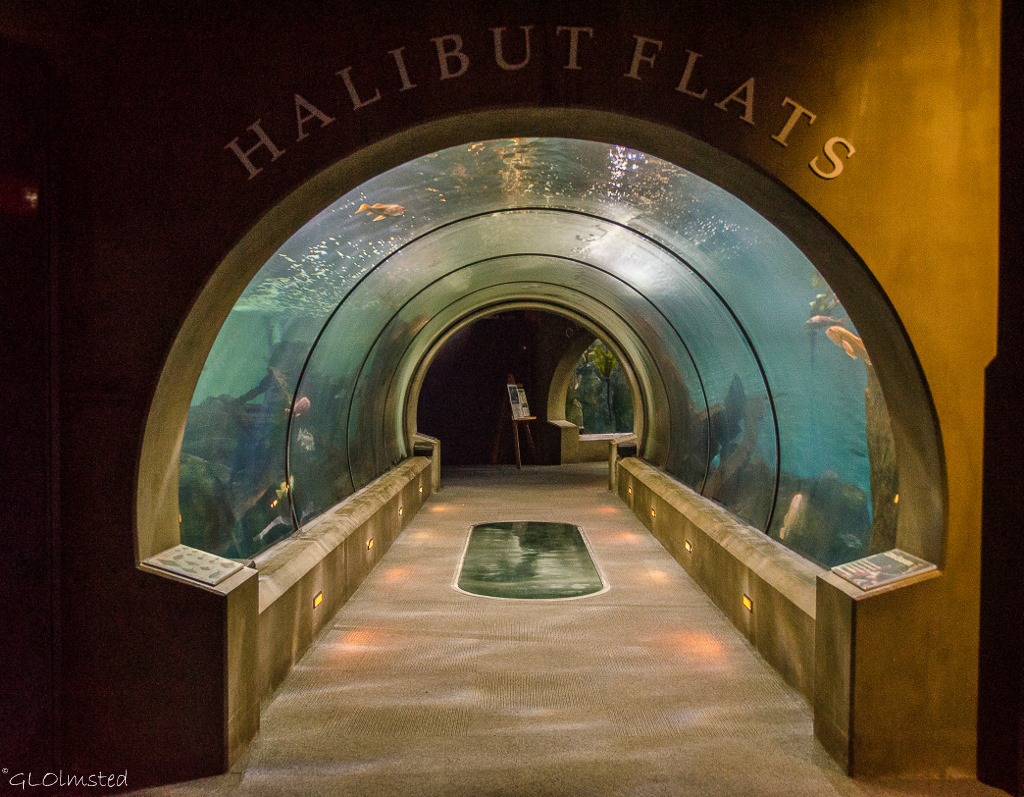 In deeper water, Halibut Flats provides ocean life shelter among the sunken skeleton of a long-forgotten ship.
In deeper water, Halibut Flats provides ocean life shelter among the sunken skeleton of a long-forgotten ship.
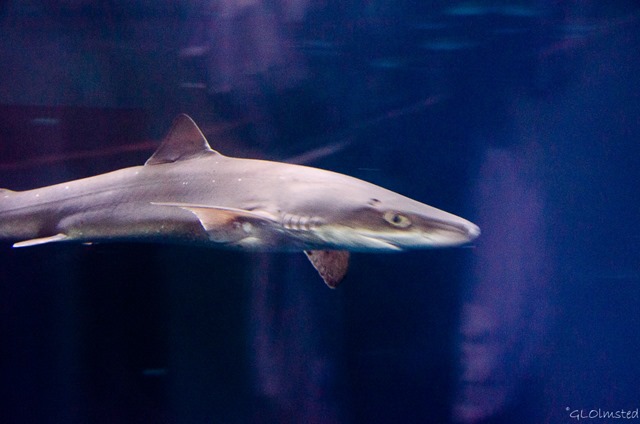 And finally into the Open Sea where species live in the upper strata of water commonly referred to as the Sunlit Zone.
And finally into the Open Sea where species live in the upper strata of water commonly referred to as the Sunlit Zone.
 This two-hour tour into the sea ended at a second gift shop and a lovely walk along the estuary returned us to the main lobby. I may have been hesitant at first but am very impressed with the thought that went into all these exhibits set on only 23 acres (9 ha). It also proved to be a photographic challenge shooting from darks to lights, with reflections and into water. And although I’m not typically a water-baby, I left with a better connection to the sea.
This two-hour tour into the sea ended at a second gift shop and a lovely walk along the estuary returned us to the main lobby. I may have been hesitant at first but am very impressed with the thought that went into all these exhibits set on only 23 acres (9 ha). It also proved to be a photographic challenge shooting from darks to lights, with reflections and into water. And although I’m not typically a water-baby, I left with a better connection to the sea.
Education is the key to saving our oceans and all the life within. Oregon Coast Aquarium offers a living classroom to over 40,000 students a year through outreach, on site labs, exhibits, the web, sleepovers, dive and snorkel experiences. A perfect location along Yaquina Bay in Newport, Oregon the aquarium guides visitors from mountain to sea. If you can’t visit right away a virtual experience is available on their aquari-cam.
What natural landscape(s) do you connect best with?


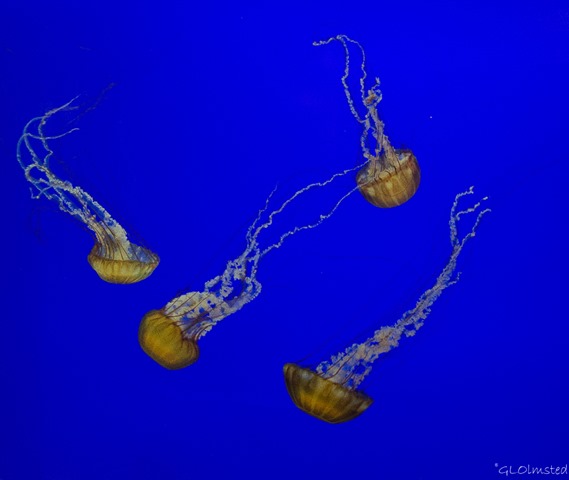
Beautiful photos, especially the one of the seals in water. This looks like a well-maintained, well-thought-out place.
Thanks Bibi. The displays are spectacular but the twisty trail through boulders is not well signed. Good thing the place is very big or I’d have gotten lost.
Great post, Heather and I spent a week in Newport years ago and the aquarium was a definite high point of the trip. It was great then and it looks like they have improved it since. They had (and still have, I checked) a geocache on the grounds. The only one I logged on the trip.
I agree that education is key to preserving wildlife. It bothers me though about so many people have a wilful ignorance of our effects on the planet.
Agree about high point in Newport. It is unfortunate that some people don’t get their connection and affects on the planet. We just need to keep spreading the word.
These are great photos, Gaelyn! I just love watching sea otters. Their slip-sliding rambunctiousness is mesmerizing. The jellyfish are another favorite – so graceful!
Thanks Barb. Didn’t see any action from the sea mammals as they had been recently fed. Could have watched the jellies’ dance for hours if we had more time.
What an amazing adventure!
The only thing missing was a wetsuit.
Gaelyn, what a fun and informative post. I do think there is value in zoos and aquariums when the animals are cared for properly. I think the educational value is immeasurable. If people cannot see and fall in love with these creatures and their habitats, there will be no motivation to save them. This looks like a wonderful place. I love the harbor seal and the otter! I am glad you were able to go and enjoy yourself.
As for me, I think my favorite habitat is the rocky mountain west. I love sage brush and mountains and big wide skies! I like the dry climate of the west, but I love still having the changing seasons. But, as you know, I also love the Sonoran desert!
I agree these facilities can be educational, as this was. Mountains, forest, canyons and deserts mostly for me.
I too am not a fan of any sort of “zoo” but I do realize that we must educate the public if we are not to destroy what we don’t know about in our arrogance. This seems a wonderful use of previously defiled land. I am so glad to hear about the otters recovery and see your darling picture. They are among my favorite water animals. I am definitely a water baby. Thanks for this tour and your great pictures.
Zoos can be a quandary but also good for education. No surprise you’re a water baby. Give me land, lots of land…
Looks like a very interesting place. Adding to our list, headed to OR next summer.
Great pictures in a very challenging surrounding for great pictures!
So many marvelous places along the Oregon Coast worthy of visiting.
Sure looks like it. Rhonda has plans for a number of one month gigs up there through out the summer. We should be able to see a bunch. Thanks for the great info and pics.
You got wonderful photos there. The last paragraph is really the reason for the Aquarium…. we’ve visited it before of course, but not for many years. However we enjoyed the Alaska Sea Life Aquarium in Seward, which is very similar in its goals. Not as elaborate, but equally as well done.
Thanks Sallie, photos were definitely a challenge. I believe in conservation through education.
Absolutely beautiful photos of the aquarium! I have so enjoyed following your trip on Facebook and now this wonderful pictorial!
Thanks. A highly recommended stop if you haven’t already been there.
We so need a place like this here where I live. They are great tourist attractions and educational tools
You do have an aquarium in Durban that I haven’t visited. And what about Bay World?
As you mention, education is key and places like these are important. I feel the same way you do about caged creatures, but there is something magical about aquariums around the world. This is a place I’d love to visit. And loving them birds you featured. I’ve only seen the rhino auklet:) They are such cool birds!
I believe you’d like this place.
Having kept this tab open for several days until I had time to sit and read, i can only echo others’ thoughts. I hate the thought of anyone or anything not being free, and yet we desperately need to see, hear, smell, and even touch where practical, other worlds, whether it’s the ocean or anywhere else, in order to understand, connect with and WANT to save them. So enjoyed this glimpse into another world! thank you!
I’m sure where you live you get more of chance than many to see and learn about ocean life. Was a very well done educational facility.